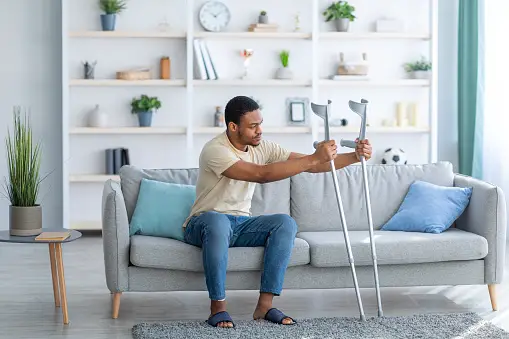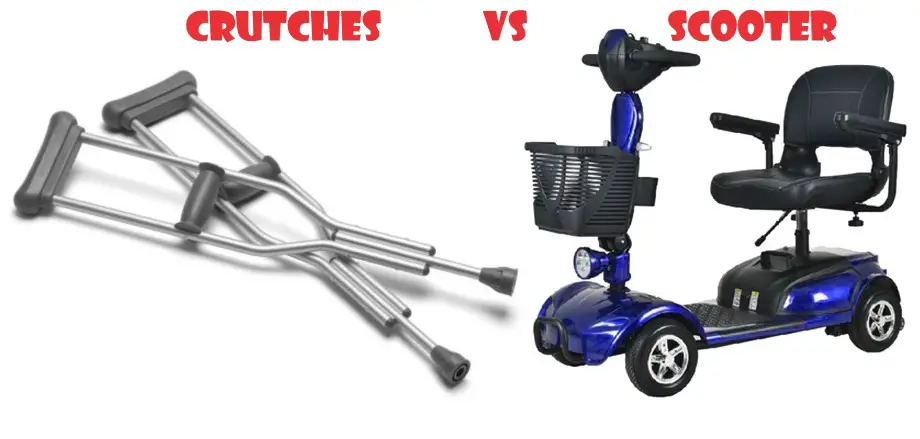Crutches and mobility scooters are both aids that help with your walking and movement from one place to the other. They both help an injured person make the most of their restricted body (or leg) movement.
Crutches are used by people whose legs cannot support their weight due to temporary injuries or permanent disabilities. They’re suitable for non-weight bearing, partial weight-bearing, and full weight-bearing situations.
Mobility scooters are mobility aids that help a person who does not have the ability or strength to walk or use a crutch to move about in a somewhat flexible manner.
A mobility scooter can serve the functions of a power wheelchair except that it is built like a motor scooter; cheaper, customizable, and easier to transport. Mobility scooters are powered by a battery; they are simply referred to as scooters when motorized.
Table of Contents
Crutches

Types of Crutches
There are three basic types of crutches.
The forearm crutches
These are quite common; their components include a single frame, forearm cuff, and handgrip. They look like a walking stick with handcuffs.
Related: Wheelchair vs. Crutches: Here’s the Right Choice after Surgery
The adjustable arthritic crutches
They aren’t as common as the others. They’re comprised of a metal padded forearm support, strap, and adjustable handpiece with a rubber ferrule. These crutches look like walking sticks with a small control tabletop. They’re usually used for patients who are on partial weight-bearing like rheumatoid arthritis.
The underarm crutches
These are the most common type of crutches. Their features include the crutch top, hand bar, and double frames joined almost at the end part by a single frame.
Scooters

Basic Components of a Mobility Scooter
A mobility scooter is basically comprised of:
Wheels
The wheels enable the scooter to move easily over the ground. It often comes with 3 or 4 wheels, depending on the type.
Related: Knee Scooter vs. Crutches: Here’s the Right One for You
A seat
This accommodates the scooter user
A battery pack
All mobility scooters are powered by a battery that can be charged onboard the scooter or through a separate battery charging unit.
Handle bars / steering wheels
They’re used to direct the scooter when using it.
The Tiller
This has speed, forward, and reverse controls. It is located at the front of the scooter as the “steering column central”. It can be controlled by a switch, finger controls, or thumb paddle.
The tiller can also consist of turn signals, light controls, speed limiters, and battery use indicators.
Categories of Scooters
Mobility scooters can come as a front-wheel drive or a back or rear-wheel drive. The scooter with rear-wheel-drive can be used both indoors and outdoors. And it can accommodate as much as 160kg or a little less. The front-wheel-drive scooter is best used indoors and can accommodate about 77kg or a little bit more.
Some scooters are small, lightweight, and can be detached into smaller parts when traveling. And some are quite large, heavy, and are mostly suitable for outdoor use and rough terrains.
Types of Mobility Scooters
Three-wheel mobility scooters
They’re the cheapest type of scooters and are most suitable indoors or quick nearby errands. They are also lightweight and have a fantastic turning radius.
Four-wheel mobility scooters
These offer more stability with the extra wheel than the three-wheel mobility scooters. They also accommodate more weight, have a longer battery life, and are more expensive than the three-wheel scooters.
Folding/travel mobility scooters
These are handy/compact when traveling or in transit. Most of them are lightweight.
Heavy-duty mobility scooters
They are comfortable and larger than other types of scooters.
Knee Scooters
Mostly help to guide your daily movement, especially if your injury keeps recurring or if you have certain physical limitations. They are mostly the most suitable alternatives for crutches.
Related: Adaptive Stroller vs. Wheelchair: Here’s the Right Choice
Pros and Cons of Crutches & Scooters
Your therapist’s opinion and the gravity of your injury are the biggest determiners of the type of mobility aid you must go for. The following could contribute to factors that will determine if crutches or scooters will help to heal your injury.
Safety and Ease
A scooter is generally easy to use than crutches because it doesn’t require you to use so much upper body strength like the crutches.
Particularly, if you are an individual who weighs quite heavy on the scale, then the crutches will seem like a very bad choice for you as you might not be able to handle it.
Although some scooters also require your upper body strength to steer them, they’re never as bad as the strength required for the crutches.
In this case, a scooter will be the best solution due to the discomfort that the crutches may cause you.
Cost/Budget
Even if they are less expensive than power wheelchairs, scooters are more expensive than crutches. Crutches are your best bet if your budget is restricted.
However, if you can afford the scooter, then why not? This factor will greatly influence your decision at the end of the day.
Maneuvering Stairways
At some point in your life and during the phase of your injury, you might just come across a flight of stairs that will be the only way to get to your destination.
In this case, it would seem like you’ve made a bad decision getting the scooter because you cannot use a scooter to cross the barrier of stairways, but crutches can do the work perfectly.
Recovery Timeframe
Scooters are sure to help your injury heal faster because the injured leg will not only be stress-free but also in genuine comfort throughout your recovery process. Whereas, if crutches aren’t used properly, they can even add to your injury and extend your recovery period.
The Right Choice
From the deductions above, having both mobility aids is the best solution for you so that each can serve its functions, depending on the circumstances you find yourself in.
However, if you cannot afford both, then the crutches seem to be a very agreeable solution since you just have to put up with the discomfort for a little while.
As a matter of fact, if the crutches are fitted, adjusted, and used properly, then you might end up having little to no discomfort because you can have them padded.




